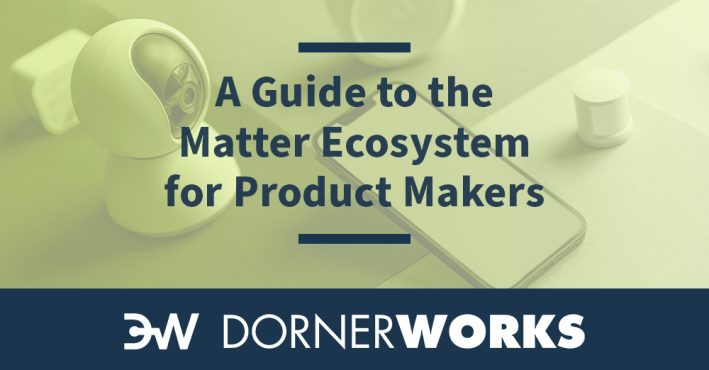
The emergence of Matter in the home automation ecosystem has garnered significant attention from tech giants such as Google, Apple, and Samsung. The consolidation of home automation under the control of these companies provides advantages for users, allowing them to manage diverse devices through a unified platform.
This consolidation may also present challenges for product makers who strive to create exceptional home automation products while being potentially sidelined from the digital experience.
There is great potential for commercialization within the Matter ecosystem, but there are also risks. By examining the potential benefits and drawbacks, device makers will have the insight to make informed decisions about Matter integration.

Matter, formerly known as Project CHIP (Connected Home over IP), is a standardized protocol developed within the Connectivity Standards Alliance, designed to facilitate seamless communication and interoperability among smart devices within the home automation ecosystem. It serves as a common language that allows devices from different manufacturers to work together smoothly. The goal of Matter is to simplify the user experience, enhance device compatibility, and support the growth of the smart home industry.
The significance of Matter lies in its potential to unify the fragmented landscape of home automation. With Matter, users can expect a more streamlined and intuitive control over their smart devices, irrespective of the brand or product type. By establishing a common foundation for communication, Matter eliminates the need for multiple apps or complex integrations, making it easier for consumers to adopt and manage smart home technologies.
The development of Matter is driven by a collaboration of major industry players, including Google, Apple, Samsung, and various other influential technology companies. These organizations have recognized the value and importance of establishing a standardized framework that benefits both consumers and device makers. By working together, they aim to create a cohesive ecosystem that fosters innovation, expands device compatibility, and promotes the widespread adoption of smart home technologies.
Google’s involvement in Matter will enable the company to provide users with a seamless and integrated smart home experience through its Google Home ecosystem. Apple, known for its commitment to privacy and user-friendly interfaces, aims to leverage Matter to enhance the interoperability of its HomeKit platform. Samsung, with its SmartThings ecosystem, seeks to ensure that its devices seamlessly integrate with other Matter-enabled products. By aligning their efforts, these key players are striving to establish Matter as the de facto standard for home automation, benefiting both end-users and device manufacturers alike.

Fancy Fans, a leading ceiling fan manufacturer, faced many challenges with their IoT-enabled models. Customers loved the capabilities that came with their high-tech fans but hated the mobile app to control them. It was always crashing and never supported the latest OS versions. Fancy Fans struggled with how to improve their customers’ experience. The mobile apps and cloud services were significant cost burdens and didn’t drive additional revenue beyond the sale of the fans, so funding their maintenance was a constant battle.
By developing new units that adhered to the standardized fan control interface specified by Matter, Fancy Fans transformed their products into a unified ecosystem. With this common language, they no longer required manufacturer-specific apps for fan control.
By creating Matter-certified fans, Fancy Fans could leverage the Apple and Google Home apps as control interfaces and eliminate their proprietary app and associated development burdens. With simplified operations, they continue offering IoT-enabled fans, ensuring seamless integration with popular platforms.

SuperHouse Technology, a leading player in the home security industry, has successfully expanded their product line to offer cutting-edge smart home solutions. However, integration efforts have traditionally demanded significant investments. To overcome this challenge, the introduction of the Matter specification becomes a game-changer for SuperHouse.
By harnessing the power of Matter’s interoperability, SuperHouse Technology can now seamlessly integrate products from different manufacturers, reducing complexities and enhancing the overall smart home experience. This eliminates the need for customers to juggle multiple apps, providing a unified and convenient control interface.
While recognizing the value of established platforms like Apple and Google Home apps, SuperHouse differentiates itself by offering an innovative mobile app and purpose-built smart home hubs. These dedicated solutions go beyond the capabilities of existing apps, empowering users with advanced features and customizations tailored specifically to their needs.
With the simplified integration made possible by Matter, SuperHouse stays ahead of the competition, securing their position as a leader in the industry. By adopting Matter, they ensure their integration efforts remain agile and future-proof, avoiding the risk of losing market share to competitors. SuperHouse delivers comprehensive smart home solutions, offering seamless control, enhanced security, and truly meaningful experiences that surpass customer expectations.
The emergence of Matter in the home automation ecosystem presents both opportunities and challenges for product makers. The advantages of adopting Matter include offloading the digital experience burden, consolidation of control, enhanced user interface, and increased interoperability. These benefits can simplify product development, enhance user satisfaction, and expand market reach. However, there are also potential downsides, such as limiting the digital experience, loss of control, and considerations around existing app investments.
Device makers must carefully evaluate the trade-offs and align their decisions with their specific business goals.
DornerWorks engineers have expertise enhancing product experiences with the Matter ecosystem. Schedule a meeting with our team when you are ready to turn your connected product ideas into reality.
DornerWorks embedded engineer Nate Bowen contributed to this blog